ATLAS ELEKTRONIK to deliver Bow and Towed Sonar systems for new Royal Thai Navy frigate
Posted on December 20, 2013
ATLAS ELEKTRONIK GmbH has been commissioned by the Korean yard Daewoo Shipbuilding & Ma- rine Engineering (DSME) with the supply and integration of a bow sonar (ASO) as well as a low- frequency active towed array sonar (ACTAS) for a new frigate of the Royal Thai Navy.
Delivery of the systems is planned to take place early in 2016.
Together, the two systems offer active and passive sonars for the detection, tracking and classification of underwater vehicles, such as submarines, torpedoes and unmanned underwater vehicles (UUV). In addition, these sonars are able to detect and classify small speedboats, divers or floating obstacles, e.g. containers or tethered mines.
The ASO bow sonar operates in the frequency range between 6 and 9 kHz and provides a surveillance radius of up to 15 kilometres around the ship. This makes it most suitable for the self-protection of the ship. The towed array sonar ACTAS operates in the low-frequency range from about 2 kHz and permits observation of the sea space at ranges considerably above 60 kilometres, depending on the propagation conditions of the water. This gives the sonar an operational range that by far exceeds that of radars and the weapons range of submarines. The system is therefore not only ideal for hunting submarines but also for the wide-area reconnaissance of surface combatants.
Both sonar systems represent the state of the art from ATLAS ELEKTRONIK and, besides newly devel- oped signal processing methods, offer a unified hardware design with the corresponding simplifications in servicing and support. Source navaltoday.com
Main image source headshot.tnews.co.th
EA to Provide Torpedo Launcher Systems for Thai, Philippines & Malaysian Navies
Cohort company SEA will look to build upon growing demand in South East Asia for its torpedo and decoy launcher systems when it highlights the capability at the Defense and Security exhibition in Ban Mai, Thailand, on November 6-9.
SEA has recently won an order to provide Hyundai Heavy Industries (HHI) in South Korea with Torpedo Launcher Systems (TLS) for two new frigates being built for the Philippines Navy and is also engaged in providing TLS and weapons handling systems for a new class of Combatant Ships under construction for Malaysia. This follows the supply of a TLS for the Royal Thai Navy’s latest frigate, which was built by DSME in South Korea.
SEA is looking to build upon this pedigree with the supply of a triple trainable deck mounted system for a further frigate under consideration by the Royal Thai Navy. In addition, there are several more opportunities in frigate new build and refurbishment projects throughout SE Asia.
One of the major benefits of SEA’s TLS is that they can be configured to fire any NATO standard light weight torpedo, enabling operators to benefit from the flexibility of choosing the best weapon independently and the option of re-configuring during the life of the ship.
The modular nature of the SEA TLS also means that by utilising a common tube selection panel as part of the combat management system the fire control electronics can be adapted to interface with the ship’s decoy launchers as well as the TLS.
SEA’s SE Asia Vice President, Strategic Accounts, David Hinds explains: “Our systems are based on over 30 years s of experience supplying and supporting the UK Royal Navy and there is a growing demand for our launchers in SE Asia.”
In addition, SEA’s torpedo and decoy launchers are being developed to integrate with the company’s thin line KraitArray towed Anti-Submarine Warfare (ASW) sonar as part of a wider detection and countermeasures defence system – Krait Defence System – that uses common software to integrate SEA’s proven range of launchers. Source navyrecognition.com
The State Department approved a possible FMS to Thailand for RGM-84L Harpoon Block II Surface Launched Missiles: Here

Excerpt
WASHINGTON, Aug. 10, 2017 – The State Department has made a determination approving a possible Foreign Military Sale to the Government of Thailand for RGM-84L Harpoon Block II Surface Launched Missiles. The estimated cost is $24.9 million. The Defense Security Cooperation Agency delivered the required certification notifying Congress of this possible sale on August 9, 2017.
- HTMS Tachin (FFG-471) – fitting out (New name HTMS Bhumibol Adulyadej)
- HTMS Prasae (FFG-472) – under construction
Progress report
Welcoming ceremony of H.T.M.S. Bhumibol Adulyadej (FFG 471) – Video: Here

Arrived in Thailand
on Jan 05, 2019
Dated Dec 14, 2018
Royal Thai Navy’s new Frigate FFG-471 HTMS Tachin Delivery Ceremony at Daewoo Shipbuilding & Marine Engineering( DSME) Okpo-Dong shipyard, Geoje, South Gyeongsang, Busan, Republic of Korea, 14 December 2018

Image from the internet
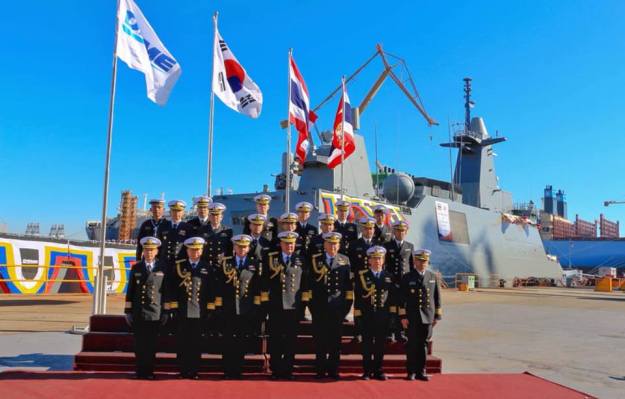
Tik smile
Dated Jan 25, 2017
Dated Jan 22, 2017

headshot.tnews.co.th

Navy for life

Navy for life
Dated Jan 19, 2017

(ร.ล.ท่าจีน 471 – HTMS Thachin 471) Image: thaidefense-news.blogspot.com DD Jan 18, 2017
*ความคืบหน้า โครงการต่อเรือฟริเกตสมรรถนะสูง ของกองทัพเรือไทย
เรือฟริเกตสมรรถนะสูง (ร.ล.ท่าจีน 471) ของกองทัพเรือไทย ซึ่งกำลังทำการต่อที่อู่ DSME ประเทศเกาหลีใต้ มีรายงานว่า วันจันทร์ที่ 23 ม.ค.2560 พลเรือเอก ณะ อารีนิจ ผู้บัญชาการทหารเรือ จะเดินทางไปเป็นประธานในพิธีปล่อยเรือลงน้ำเพื่อติดตั้งระบบอาวุธและระบบไฟฟ้า..Source thaidefense-news.blogspot.com

thaidefense-news.blogspot.com DD Oct 26, 2016
DW 3000F class : 2 (one will be constructed in Korea and one in Local )
A ship Frigate has been selected. The series was developed from class destroyer Kwanggaeto Class Destroyer (KDX-I), which ships the Navy Frigate supply. Designing and building ships Using the standard US military. And Korea Navy The certification is recognized by the Institute classified the ship, a member of IACS (International Association of Classifications Society) by such a ship. Is liable to a maximum of 3,700 tons of water, maximum speed 30 knots continuous operating range of around 4,000 nautical miles, the nature of the ship’s 136 troops designed using Stealth. Technology and reduces diffusion magnetic resonance hull.Including reducing the spread of sound underwater. Install a combat system and weapons from Europe and America. The combat operations as well as three-dimensional self-defense at close range. By European standards, the US Navy and is currently in use and supply.
Boat building is carried out at the company’s shipyard DSME in South Korea during the years 2556 – 2561 built vessel, with wages totaling about 14,600 million baht, the price including VAT. Parts, tools, documentation, support the experimental testing, training, technology transfer and other related issues.

Reportedly, HTMS Tachin (FFG-471) is one of the two DW 3000F class warships built by South Korea’s Daewoo Marine Group for the Royal Thai Navy. And in the process of returning home this ship with a visit to some Asian countries. Images of HTMS Tachin visited Hong Kong to get essentials on December 26 last. Photo source: Richard Yip
Armament
Weapon system
Bridge

True4U

True4U

True4U

True4U

True4U

True4U

True4U

True4U

True4U

True4U

True4U

True4U

True4U

True4U
Interior

True4U

True4U
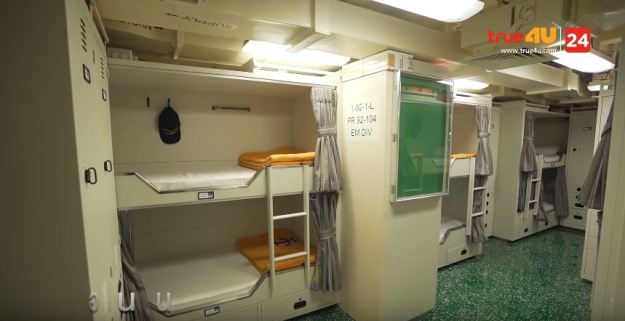
True4U

True4U

True4U

True4U

True4U

True4U

True4U

True4U
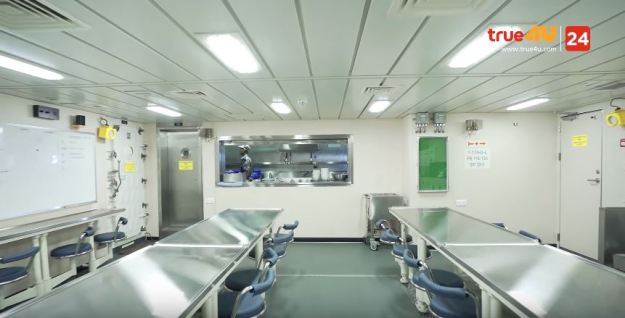
True4U

True4U

True4U

True4U

True4U

True4U
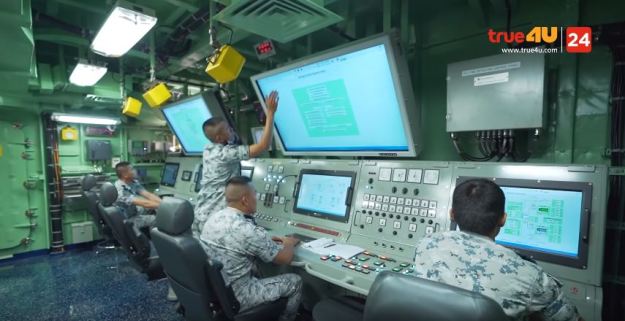
True4U

True4U

True4U

True4U

True4U

True4U

True4U

True4U
Fire Control Systems
Oto Melara 76/62 Stealth Shield, Multi feeding system

H.T.M.S. Bhumibol Adulyadej (FFG 471) – Surin Lertseethong
Technical data:
Caliber: 3 inches / 76,2 mm
Barrel lenght: 186 inches / 4,72 meters (= 62 caliber)
Weight: 7900kg, empty (Super Rapid)
Shell: 76 x 900 mm / 12,34 kilograms
Elevation: – 15° to + 85°
Traverse: 360°
Rate of fire: Compact: 85 rpm / Super Rapid: selectable from single shot up to 120 rpm
Muzzle Velocity: 925 m/s (1100 m/s – DART)
Magazine: Compact: 80 rounds / SR: 85 rounds
Range:
16 kilometers with standard ammunition
20 km with extended range ammunition
up to 40 km with VULCANO ammunition

H.T.M.S. Bhumibol Adulyadej (FFG 471) – Thairath
Ammunition:
– HE (high explosive) – 6,296kg / Range 16km / effective range 8km (4km vs. air targets at elev. 85°)
– MOM (multi-role OTO munition)
– PFF (pre-formed fragmentation) – anti-missile ammunition
– SAPOM (semi-armored piercing OTO munition) – 6,35kg / Range 16km
– SAPOMER (semi-armored piercing OTO munition, extended range) – Range 20km
– DART (driven ammunition reduced time of flight) – sub-calibre guided ammunition against multiple targets
(missiles and maneuvering targets at sea) 4,2kg in barrel / 3,5kg in flight / 660mm lenght / effective range >8km
– VULCANO (76mm unguided and guided extended range ammunition) – under development
Source seaforces.org
 1 × OTO Melara 76 mm
1 × OTO Melara 76 mm
1 x CIWS
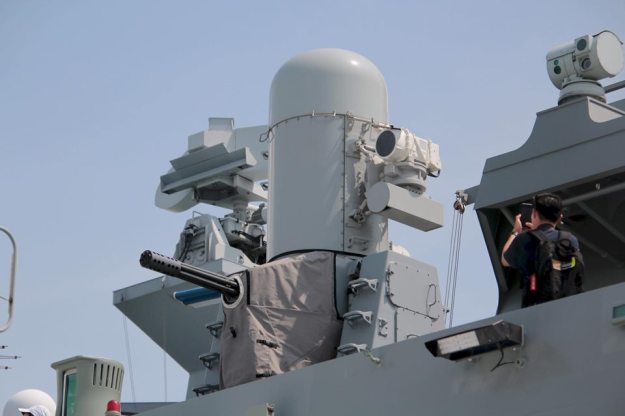
H.T.M.S. Bhumibol Adulyadej (FFG 471) – Surin Lertseethong
2 x 30 mm Guns

H.T.M.S. Bhumibol Adulyadej (FFG 471) – Surin Lertseethong
2 x DS-30M automated small calibre gun 30mm DS30M Mark 2 is a ship-protection system made by MSI-Defence Systems consisting of a 30mm Mark 44 Bushmaster II cannon on an automated mount. (wiki)
8 x SSM
General characteristics:
Primary function: Air-, surface-, or submarine-launched anti-surface (anti-ship) missile
Contractor: McDonnell Douglas (now Boeing)
Power plant: Teledyne CAE J402 turbojet, 660 lb (300 kg)-force (2.9 kN) thrust, and a solid-propellant booster for surface and submarine launches
Length: Air-launched: 3.8 metres (12 ft) / Surface and submarine-launched: 4.6 metres (15 ft)
Weight: Air-launched: 519 kilograms (1,144 lb) / Submarine or ship launched from box or canister launcher: 628 kilograms (1,385 lb)
Diameter: 340 millimetres (13 in)
Wing span: 914 millimetres (36.0 in)
Maximum altitude: 910 metres (2,990 ft) with booster fins and wings
Range:
Over-the-horizon (approx 50 nautical miles)
AGM-84D (Block 1C): 220 km (120 nmi)
RGM/UGM-84D (Block 1C): 140 km (75 nmi)
AGM-84E (Block 1E): 93 km (50 nmi)
AGM-84F (Block 1D): 315 km (170 nmi)
RGM-84F (Block 1D): 278 km (150 nmi).
RGM/AGM-84L (Block 2): 278 km (150 nmi)
AGM-84H/K (Block 1G / Block 1J): 280 km (150 nmi)
Speed: High subsonic, around 850 km/h (460 knots, 240 m/s, or 530 mph)
Guidance: Sea-skimming cruise monitored by radar altimeter, active radar terminal homing
Warhead: 221 kilograms (487 lb), penetration high-explosive blast
Unit cost: US$1,527,416
Source seaforces.org

H.T.M.S. Bhumibol Adulyadej (FFG 471) – Surin Lertseethong

H.T.M.S. Bhumibol Adulyadej (FFG 471) – Surin Lertseethong
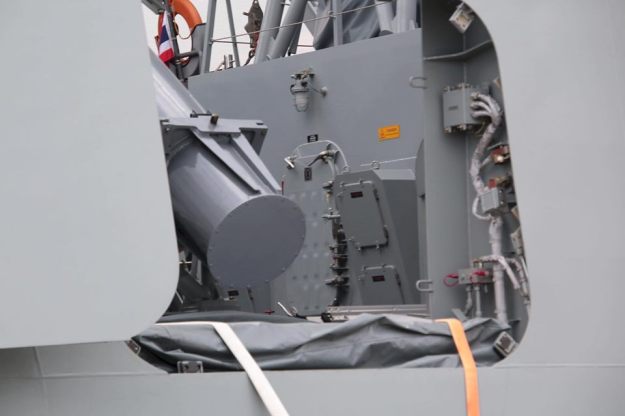
H.T.M.S. Bhumibol Adulyadej (FFG 471) – Surin Lertseethong
8 x Canisters (max 32 ESSM)

8 cell Mk.41 vertical launch system “quad-packed”

32 x RIM-162 ESSM – RIM-162 Evolved SeaSparrow Missile (ESSM)

32 x RIM-162 ESSM – RIM-162 Evolved SeaSparrow Missile (ESSM) is a development of the RIM-7 Sea Sparrow missile used to protect ships from attacking missiles and aircraft. ESSM is designed to counter supersonic maneuvering anti-ship missiles. ESSM also has the ability to be “quad-packed” in the Mk 41 VLS system, allowing up to four ESSMs to be carried in a single cell. Compared to the Sea Sparrow, ESSM has a larger, more powerful rocket motor for increased range and agility, as well as upgraded aerodynamics using strakes and skid-to-turn. In addition, ESSM takes advantage of the latest missile guidance technology, with different versions for Aegis/AN/SPY-1, Sewaco/APAR, and traditional target illumination all-the-way. The improved ESSM Block II will be fielded by the US Navy from 2020. (wiki)
General Characteristics:
Primary Function: Surface-To-Air and Surface-To-Surface radar-guided missile.
Contractor: Raytheon Missile Systems, Tuscson, Ariz.
Date Deployed: 2004
Unit Cost: $787000 – $972000 depending on configuration
Propulsion: NAMMO-Raufoss, Alliant (solid fuel rocket)
Length: 12 feet (3,64 meters)
Diameter: 8 inches (20,3 cm) – 10 inches (25,4 cm)
Weight: 622 pounds (280 kilograms)
Speed: Mach 4+
Range: more than 27 nmi (more than 50 km)
Source seaforces.org
SM-2 standard missile (Provision for)

The RIM-66C/D Standard MR (SM-2MR Block I), was developed in the 1970s and was a key part of the Aegis combat system and New Threat Upgrade (NTU). The SM-2MR introduced inertial and command mid-course guidance. The missile’s autopilot is programmed to fly the most efficient path to the target and can receive course corrections from the ground. Target illumination for semi-active homing is needed only for a few seconds in the terminal phase of the interception. This capability enables the Aegis combat system and the New Threat Upgrade equipped vessels to time share illumination radars, greatly increasing the number of targets that can be engaged at one time. In the middle 1980s, the SM-2MR was deployed via Mk-41 Vertical Launch System (VLS) aboard the USS Bunker Hill, the first U.S. Navy ship to deploy a vertical launcher. VLS has, since 2003, been the only launcher used for the Standard missile in the U.S. Navy aboard Ticonderoga-class cruisers and Arleigh Burke-class destroyers.
The Standard can also be used against ships, either at line-of-sight range using its semi-active homing mode, or over the horizon using inertial guidance and terminal infrared homing.

SM-2 Medium Range Block I, RIM-66C/D:
The RIM-66C was the first version of the Standard missile two. The missile became operational in 1978 with the Aegis combat system fitted to the Ticonderoga class cruiser. The RIM-66D was the SM-2 medium range block I version for the New Threat Upgrade. The SM-2 incorporates a new autopilot giving it inertial guidance in all phases of flight except for the terminal intercept where semi-active radar homing is still used. This version is no longer in service, remaining missiles have either been remanufactured into later models or have been put in storage.
SM-2 Medium Range Block II, RIM-66G/H/J:
The Block II missile introduced in 1983 with a new rocket motor for longer range and a new warhead. The RIM-66G is for the Aegis combat system and the Mk26 missile launcher. The RIM-66H is for Aegis and the Mk41 vertical launcher. The RIM-66J is the version for the New Threat Upgrade. Block II missiles are no longer manufactured, and have been withdrawn from service. The remainder have either been put in storage, or remanufactured into later models.
SM-2 Medium Range Block III/IIIA/IIIB, RIM-66K/L/M:
The RIM-66M is the version of the Standard missile two medium range (SM-2MR) currently in service with the USN aboard Ticonderoga class cruisers, and Arleigh Burke class destroyers. The missile is specifically designed for the Aegis Combat System and the Mk41 Vertical launch system. The Block III missiles differ from earlier blocks by the addition of the MK 45 MOD 9 target detecting device, for improved performance against low altitude targets. The Block IIIB missile additionally has a dual semi-active/infrared seeker for terminal homing. The dual seeker is intended for use in high-ECM environments, against targets over the horizon or with a small radar cross section. The seeker was originally developed for the canceled AIM-7R Sparrow air-to-air missile. All USN Block III and IIIA missiles are to be upgraded to Block IIIB. Block IIIA missiles are operated by the Japanese Maritime Self-Defense Force on its Kongo class and Atago class Aegis destroyers. Aegis equipped vessels in the Spanish and South Korean navies use it as well. The Dutch and German Navies have added it to the Anti-Air Warfare system, which uses the Thales Nederland Active Phased Array Radar and Smart-L radar. South Korean KDX-II destroyers use the block IIIA with a New Threat Upgrade compatible guided missile fire control system. Block III variants for Aegis and arm launchers are designated RIM-66L. Block III missiles for New Threat Upgrade systems is designated RIM-66K. Block IIIB missiles were not produced for the New Threat Upgrade. Blocks IIIA and IIIB are the current production versions. The Thales Nederland STIR 1.8 and 2.4 fire control systems are also supported.
Weight: SM-2MR = 1558 lb (707 kg)
Lenght: 15 feet 6 inch (4,72 meters)
Engine: solid fuel rocket
Range: 40 to 90 nmi (74 to 170 kilometers)
Ceiling: 80100 feet (24400 meters)
Speed: Mach 3,5
Source seaforces.org
1 × VL-ASROC

The VLA is intended to provide vertical-launch-capable surface combatants with an all-weather, 360-degree quick-reaction, standoff antisubmarine weapon capability. It is carried by Aegis-equipped ships (cruisers and destroyers) equipped with the Mk-41 Vertical Launching System (VLS) and the SQQ-89 ASW Combat System. VLA includes a solid-propellant booster thrust vector control (TVC), and a digital autopilot control (DAC) to guide the missile from a vertical orientation through a pitch-over maneuver into a ballistic trajectory intended to deliver the torpedo to an aim point on the ocean surface. Originally deployed with the Mk-46 Mod 5A(S) torpedo, all VLAs have been upgraded with the Mk-46 Mod 5A (SW) torpedo. This variant of the Mk-46 torpedo provides improved performance in shallow water. With Initial Operational Capability (IOC) of the Mk-54 Lightweight Torpedo in 2010, a program is currently underway to upgrade the VLA inventory with the Mk-54 Lightweight Torpedo. VLAs with Mk-54 torpedoes are planned for fleet delivery in FY 2010.
Contractor: Lockheed Martin
Propulsion: Solid propellant rocket
Length: 16.7 feet (5,1 meters)
Diameter: 14.1 inches (35,8 centimeters)
Weight: 1,650 pounds (748 kilograms)
Range: 24000 yards (22 kilometers)
Warhead: Mk-46 torpedo, Mk-54 MAKO torpedo
Source seaforces.org
2 × Mk.32 torpedo tubes triple launch tubes
Mark 54 Lightweight Hybrid Torpedo (LHT)
The MK 54 Lightweight Torpedo was previously known as the Lightweight Hybrid Torpedo (LHT).
The MK 54 Mod 0 Lightweight Torpedo integrates existing torpedo hardware and software from the MK 46, MK 50 and MK 48 torpedo programs with state-of-the-art commercial-off-the-shelf digital signal-processing technology. It incorporates an advanced guidance and control section employing COTS processing technologies and tactical software improvements to significantly increase shallow water counter-countermeasure capability at reduced lifecycle costs. These features provide performance improvements in the most challenging littoral scenarios.
Future development will continue to provide improvements to shallow water performance via software Advanced Processor Build upgrades, and the MK 54 Mod 1 adds a new sonar array assembly and improved processing capability. The MK 54 Mod 0 Lightweight Torpedo reached Initial Operational Capability in 2004. The MK 54 Vertically Launched ASW Rocket (ASROC)(VLA) system reached IOC in 2010. Source military.com
2 x .50 caliber machine gun

Nulka active missile decoy

H.T.M.S. Bhumibol Adulyadej (FFG 471) – Surin Lertseethong
Nulka is an Australian designed and developed active missile decoy built by an Australian/American collaboration.
It is a rocket propelled, disposable, offboard, active decoy designed to seduce anti-ship missiles away from their targets. It has a unique design in that it hovers in mid air while seducing the incoming anti-ship missile.
The hovering rocket concept was initiated in Australia by the Defence Science and Technology Organisation (DSTO), and the system was designed, developed and then manufactured by AWA Defence Industries (AWADI) (now BAE Systems Australia).
The Nulka consists of the missile itself enclosed in a hermetically sealed canister. This canister is then contained in a Launcher module. Source navy.gov.au
Nulka decoy

The Decoy Launching System (DLS) Mk 53 (NULKA) is a rapid response Active Expendable Decoy (AED) System capable of providing highly effective defense for ships of cruiser size and below against modern radar homing anti-ship missiles. Nulka is being developed in cooperation with Australia (in the Australian Aboriginal dialect, “Nulka” means “be quick!”). It is intended to counter a wide spectrum of present and future radar-guided anti-ship missiles (ASMs) assessed to have passive decoy rejection and active angular deflection electronic countermeasures rejection capabilities. It is designed to over-come the inherent shortfalls of chaff, which are wind dependence, lack of placement flexibility, relatively slow reaction time, and susceptibility to Doppler discrimination.
The system can either be integrated with the Combat System or used with the stand-alone AED Fire Control System. The DLS MK 53 Mod 4 is a modified DLS MK 36 Mod 12 by the addition of two NULKA launching tubes to each of the four MK 137 Mod 2 launchers and a Decoy Launch Processor.
The Nulka decoy employs a broad-band radio frequency repeater mounted atop a hovering rocket platform. After launch, the Nulka decoy radiates a large, ship-like radar cross section while flying a trajectory that seduces and decoys incoming ASMs away from their intended targets. The NULKA decoy is an active offboard decoy which utilizes a broad band radio frequency repeater mounted atop a hovering rocket. The decoy is an autonomous flight vehicle, capable of operating over a wide range of environments and of positioning the payload with a high level of accuracy. The decoy employs the hovering rocket principle and uses a solid state microprocessor autopilot and thrust vector control. The decoy is designed to counter a wide variety of present and future radar Anti-Ship Missile (ASM) guided threats by radiating a large radar cross section signal while flying a ship-like trajectory thus enabling one decoy to counter multiple threats. The flight trajectory is determined by a digital Flight Control Unit mounted immediately above the rocket motor. The combination of thrust and flight control enables successful decoy launches to be accomplished even in severe sea state and high wind conditions. The Processor Power Supply controls the decoy launching by igniting the decoys thermal batteries, monitoring the decoy self check process, downloading the decoy flight program and then igniting the rocket motor. Once launched the decoy operates autonomously and follows the stored flight demands, moving away from the ship at a pre-programmed height and speed and thus presenting an alternative and more attractive target to incoming missiles.Australia is developing the hovering rocket, launcher, and launcher interface unit. The United States is developing the electronic payload and fire control system, which is presently being integrated into the SSDS. Recent upgrades to Nulka include improved payload to reduce cost and modifications to the fire control system to reduce the system’s overall weight.The existing Mk 36 Decoy Launching System is being modified to support Nulka launches. After the Nulka equipment is installed, the system is redesignated as a Mk 53 DLS. Nulka can be used as part of a multi-layer defense system, or it can be used for stand-alone ship protection. The Nulka Decoy System has been successfully tested as a part of the Navy’s Ship Self Defense System (SSDS). Introduction priority will be given to ship classes that are presently without an active electronic warfare suite to provide an increased ASM defense capability. Due to the ever changing complexity of Anti-Ship Cruise Missiles, Nulka will be continually upgraded in order to provide protection to the Fleet. Changes will include technology advancement as well as tactical and technical changes to counter the threat. Source fas.org
Sensor
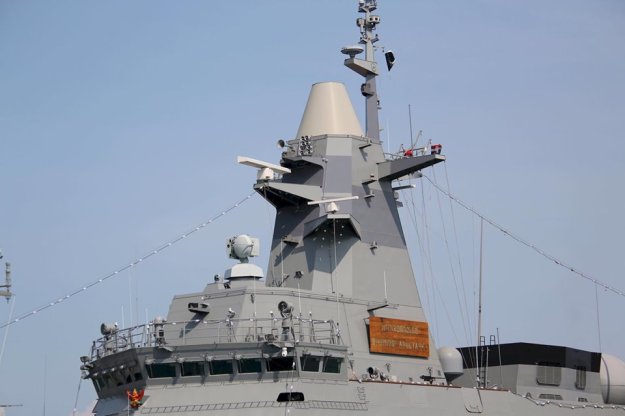
H.T.M.S. Bhumibol Adulyadej (FFG 471) – Surin Lertseethong
Fire Control Systems
CEROS 200 fire control radar

H.T.M.S. Bhumibol Adulyadej (FFG 471) – Surin Lertseethong
The CEROS 200 comprises multiple sensors, including EO, IR, TV and Laser. In addition, it has an advanced video tracker to enable simultaneous TV and IR tracking. The radar director pedestal is of twoaxis, elevation over azimuth type, and incorporates direct-drive hydraulic motors with built-in hydrostatic bearings. The freedom of motion in azimuth is unlimited and all electrical signals are transferred via slip rings. In elevation the motion is controlled both by electrical and mechanical end stops. For stabilisation against ship motion and angular rate measurements of the pedestal, a two-axis measurement gyro is used. The gyro features high performance and reliability. At turn-off, the director is automatically slewed to parking position and secured with hydraulic locking pins. A key feature is its high ability when tracking with low angular speed. The CEROS 200 has a hydraulically-driven pedestal with a much higher Mean Time Between Failure compared with alternative approaches such as electro-driven systems.
KEY STRENGTHS:
- Extremely high accuracy
- Fast reaction
- Extremely high availability
- Patented CHASE algorithm
- Proven performance
- Unique capabilities
- Long range
- Extremely wide bandwidth (2 GHz)
- Low weight
- Low lifecycle cost
- Inherent growth potential
Source Saab
| GENERAL DATA: | |
|---|---|
| Type: Radar | Altitude Max: 30480 m |
| Range Max: 74.1 km | Altitude Min: 0 m |
| Range Min: 0.2 km | Generation: Early 2000s |
| Properties: Moving Target Indicator (MTI), Pulse Doppler Radar (Full LDSD Capability), Continuous Wave Illumination |
| SENSORS / EW: |
|---|
| CEROS 200 Tracker [9LV Mk4 ESSM] – Radar Role: Radar, FCR, Surface-to-Air & Surface-to-Surface, Short-Range Max Range: 74.1 km |
Source cmano-db.com
EOS 500 integrated with CMS

H.T.M.S. Bhumibol Adulyadej (FFG 471) – Surin Lertseethong
TECHNICAL SPECIFICATIONS
| Pedestal | |
| Type | 2-axis, elevation over azimuth |
| Angular speed | < 2 rad/s |
| Angular acceleration | < 2 rad/s2 |
| Weight | < 112 kg including all sensors |
| IR Thermal imager | |
| Type | Third generation |
| Wavelength | 3-5 um or 8-12 um |
| Laser range finder | |
| Type | OPO-shifted Nd YAG |
| Wavelength | 1.57 um (eye-safe) |
| PRF | 3 Hz continuous (8 Hz during 30-sec burst) |
| Power | 115 V 50-60 Hz, 3kVA |
| Communication interface | |
| Ethernet TCP/IP | |
| Environmental conditions |
Source saab.com
Surveillance system
Sea Giraffe 4A medium- and long-range AESA surveillance radar

IMPORTANT FEATURES
- Automatic air and surface surveillance and tracking including tracking-on-jam
- Classification of both hovering and moving helicopters
- Target indication to weapon systems for both anti-air and anti-surface engagements
- 360˚ mortar/rocket alert and weapon location
- Target designation for long-range surface-to-air missiles
Extensive ECCM capability
The Sea Giraffe 4A provides extensive Electronic Counter-Counter Measure (ECCM) to meet the complex ECM environment of today and tomorrow. Methods of countering noise and deceptive jamming and chaff are included such as:
- Ultra-low side-lobe levels including side-lobe blanking
- Frequency agility; pulse to pulse, burst to burst, and scan to scan frequency agility
- Constant False Alarm Rate (CFAR) to reject false alarms caused by clutter and/or noise jamming
- PRF switching and PRF stagger with random jitters
- Intermittent (or random) transmission to confuse hostile ESMs and anti-radiating missiles
- Sector transmission that can be independently defined by the operator
- Automatic selection of least jammed frequency
- Automatic jammer detection and tracking in both azimuth and elevation
- LPI waveforms
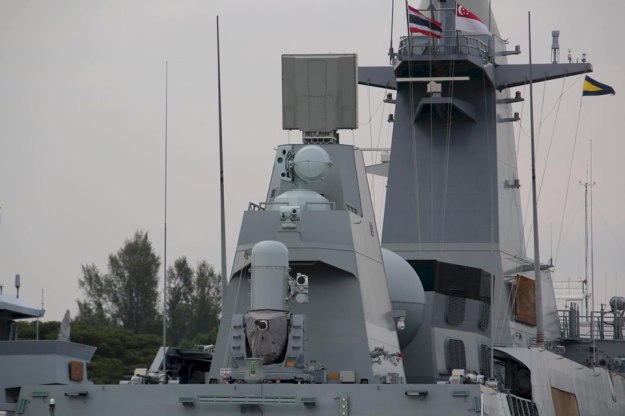
H.T.M.S. Bhumibol Adulyadej (FFG 471) – Surin Lertseethong
PRODUCT CONFIGURATION
Sea Giraffe 4A baseline configuration
The Sea Giraffe 4A has the following main hardware units:
- Antenna including RF parts and turntable (AU)
- Liquid Cooling Unit (LCU)
- Signal Data Unit (SDU)
- Power Distribution System (PDS)
Upgrading and extended capabilities
- Identification Friend or Foe (IFF) interrogator antenna
- IFF interrogator
- IFF transponder equipments

H.T.M.S. Bhumibol Adulyadej (FFG 471) – Surin Lertseethong
Technical data
| Radar type | Stacked beam 3D radar |
| Antenna type | AESA, digital beam forming |
| Frequency | S (E/F) band |
| Elevation coverage | > 70 degrees |
| Rotation rate | 30 or 60 rpm |
| Search volume | 360° or in a sector |
| Instrumented range | 280 km |
@saab.com
Giraffe 4A and Sea Giraffe 4A: medium- to long-range radars, combining air surveillance, air defence, sense and warn and weapon locating capabilities in a single, low-footprint S-band AESA-based unit.

Sea Giraffe 4A @saab
Sea Giraffe AMB
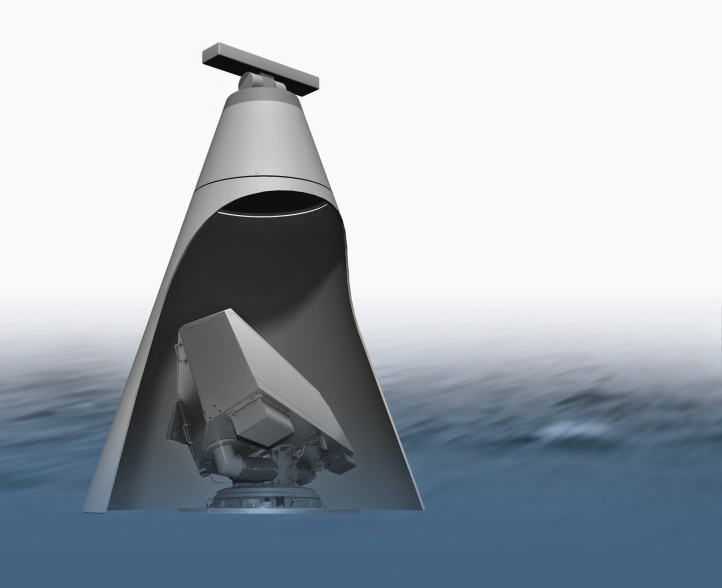
3 D Medium range radar 180 km – Sea Giraffe AMB
This multi-role 3D radar provides a full range of functions for simultaneous:
- Air surveillance and tracking, including tracking-on-jam
- Surface surveillance and tracking
- Target classification of both moving and hovering helicopters
- Navigation/close combat capabilities
- Target indication to weapon systems for precision anti-air and anti-surface engagement
- Gunfire support, including high-resolution splash spotting
The radar simultaneously detects small fast-moving targets at all altitudes and in severe clutter. The surface channel gives a high probability of detecting very small targets in close proximity to the surface, for example rib boats and periscopes.
The radar has been proven in all kinds of environments including regions with extensive ducting conditions.
The concurrently processing target returns from multiple digitally shaped narrow receive beams in elevation results in high altitude coverage and monopulse accuracy in elevation. The radar covers the full search volume every second.
In order to relieve operator interaction, Sea Giraffe AMB provides fully automatic operation on both air and surface targets, supported by a variety of different clutter maps and doppler processing to eliminate both land and weather-driven clutter.
Sea Giraffe AMB provides the most comprehensive Electronic Counter-Countermeasure (ECCM) capabilities available today including ultra-low antenna side-lobes.
MAIN HARDWARE UNITS
Today the Sea Giraffe AMB has the designation AN/SPS 77 V(1) for the US Navy’s Littoral Combat Ship, LCS 2/4 and AN/SPS 77 V(2) for LCS 6 and higher.
Sea Giraffe AMB comprises the following main hardware units:
- Antenna Unit (AU)
- Transmitter Unit (TRU)
- Signal and Data Unit (SDU)
- Power Distribution System (PDS)
The following extended capabilities for the Sea Giraffe AMB baseline product configuration are available:
- Stealth Radome
- 360˚ mortar/rocket detection and alert (C-RAM)
- Identification Friend or Foe (IFF) interrogator antenna
- IFF interrogator
- Improved detection range and redundancy with an additional transmitter unit
The stealth radome is built with Frequency Selective Surfaces (FSS) to minimise the Radar Cross Section (RCS) and infrared signature of the above-deck parts of the Sea Giraffe AMB. The radome is capable of carrying equipment on the top, for example an ESM, ELINT and/or a COMINT. The counter rocket, artillery and mortar alert function detects, tracks and classifies very small ballistic objects in severe clutter. The point of impact, the ballistic trajectory as well as the impact position are calculated. A warning signal of impact position is given well in advance, allowing the ship to perform an evasive manoeuvre in order to avoid being hit.

H.T.M.S. Bhumibol Adulyadej (FFG 471) – Surin Lertseethong
TECHNICAL SPECIFICATION
| Radar type | Stacked beam 3D radar |
| Antenna type | 3D phased array, digital beam forming |
| Frequency | C (G/H)-band |
| Elevation coverage | > 70 degrees |
| Rotation rate | 60 RPM |
| Instrumented range | 180 km |
ATLAS ELEKTRONIK Towed Sonar system
Updated Sept 24, 2019





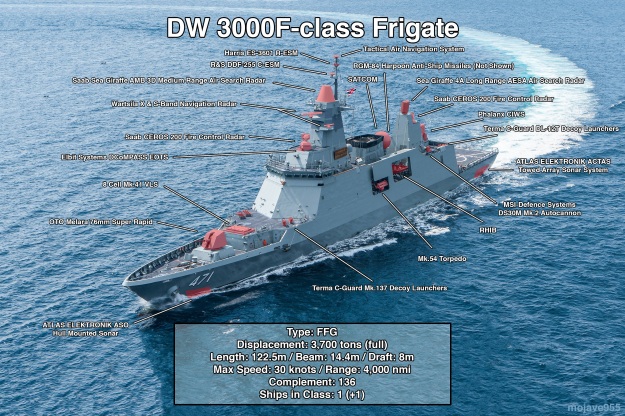

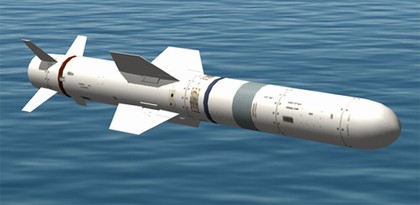






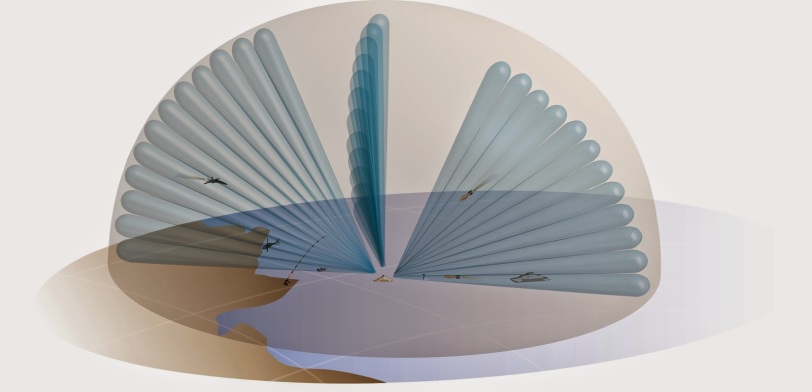



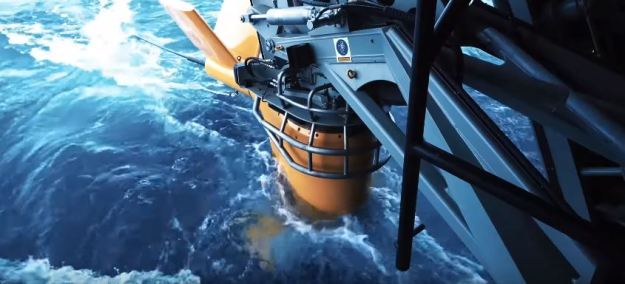
So the second one is on the building or what??
LikeLike
There is very little info on the 2nd ship but it maybe being built in Korea
LikeLike
Seem like no news on second one being built nor in order. What do you think?
LikeLike
Doubt that as they already allocated the budget as I mentioned earlier they might be some changes to the second vessel
LikeLike
So now the first one is done… And still no news about second one??? Actually we need second one.. I hope we order and built it… If you know some news Pls inform me… Thx
LikeLike
I think the delay maybe caused to some issues this is a new ship with new systems the Korean Navy version from my point of view is not as advance as the RTN version. The other problem is that RTN must order the NSM missile instead of the Harpoon. I really don’t get why RTN keep using Harpoon, Malaysia already selected NSM for their new ships. US already stopped using Harpoon and now use NSM. U.S. Navy selects the Norwegian Naval Strike Missile as its new over-the-horizon anti-ship missile https://thaimilitaryandasianregion.blogspot.com/2018/06/us-navy-selects-norwegian-naval-strike.html
LikeLike
When Thailand will buy second ship??
LikeLike
There is no news yet maybe after they get the first ship and made sea trials as they might want to make some upgrades for second ship
LikeLike
Did they start building the second ship??
LikeLike
Not yet but from what I know they have to build it in Thailand
LikeLike
how much will it cost
LikeLike
A little over $500 million per ship but RTN ordered 2 the second ship will be built in Thailand
LikeLike
how will it do compare to formidable class
LikeLike
The Thai ship is larger and faster and better all rounder than the Formidable Class see Formidable Class http://i.imgur.com/QjWkKcz.jpg
Formidable Class lack towed sonar and no anti-submarine missiles. It seems Thailand also recently bought the Land attack Harpoon https://thaimilitaryandasianregion.wordpress.com/2017/02/15/boeing-received-12-3-million-contract-from-us-navy-nine-allies-for-harpoon-missiles/
LikeLike
Sorry it does have towed sonar “Each frigate is equipped with an EDO ALOFTS Model 980 active low-frequency towed-array sonar (Variable Depth Sonar). ALOFTS (Active Low Frequency Towed Sonar) provides long, medium, and short-range detection, localization, classification, and tracking of submarines in blue and littoral water environments. ALOFTS combines a proven active acoustic source in a variable depth body with an attached towed array to receive active sonar signals.”
LikeLike
tanks
LikeLike